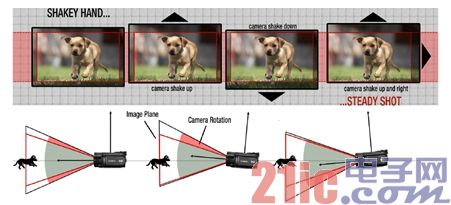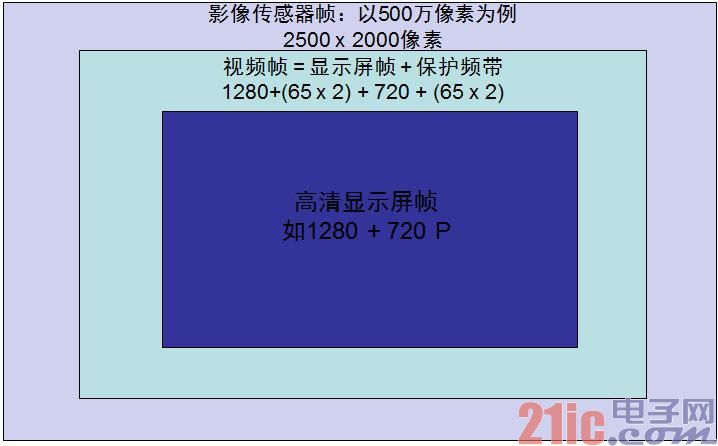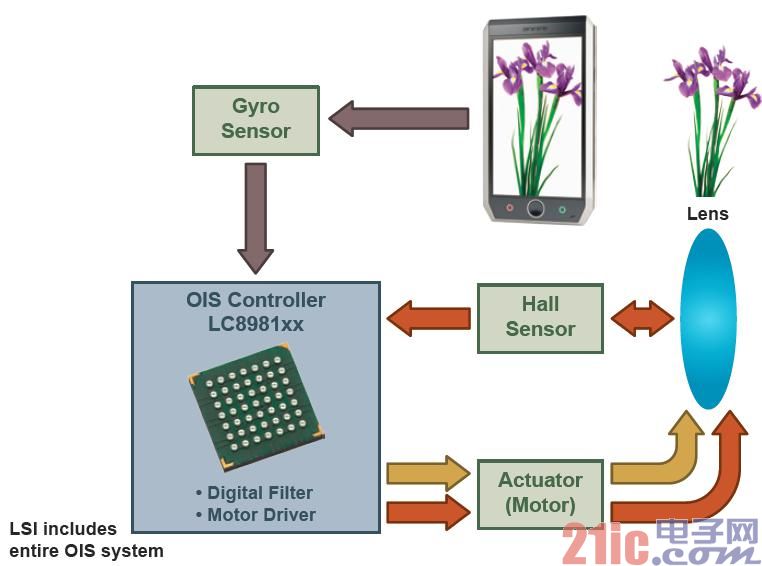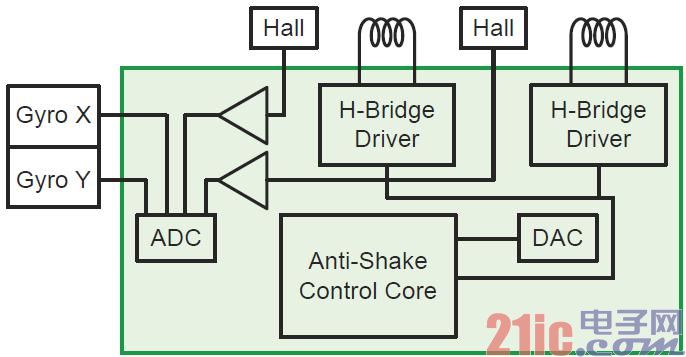Today, people are increasingly shooting through smartphones, tablets, digital cameras, camcorders and even cars. Image jitter is often encountered during camera recording. A typical example of jitter is when a person shakes the camera and shakes the image, making it difficult to view, especially when the zoom function is fully zoomed in. In addition, blurring can occur when the camera and camera capture images while moving. Therefore, designers need to use appropriate image stabilization methods to help control jitter and blur during camera and camera, optimizing the user experience.
This article refers to the address: http://
There are three main types of image stabilization methods used in mobile, consumer, and automotive applications, including Digital Image Stabilization (DIS), Electronic Image Stabilization (EIS), and Optical Image Stabilization (OIS). The main difference between DIS and EIS is the motion detection method. DIS uses the pixel mapping method, as shown in Figure 1. The DIS method places the dog in the middle by analyzing the picture. That is, the pixel mapping method re-adjusts the position of the dog with software.

Figure 1. Digital Image Stabilization (DIS) uses a pixel mapping method to stabilize images by software.
In contrast, EIS uses gyroscopes to detect camera motion and compensate motion in real time, maximizing pixel and image quality. Both methods provide motion compensation by cropping the image. Since the EIS uses a gyroscope to sense motion, the EIS sensing accuracy is excellent, but since it still compensates for motion by cropping the image, the image quality is degraded. In Figure 2, you can see how the guard band is used to crop the image to compensate for the jitter.

Figure 2. Electronic Image Stabilization (EIS) uses a gyroscope to detect camera motion and compensate.
Most applications use an application processor (AP) to process video or signals, including applications that use EIS and DIS. In particular, DIS requires more processor resources to compensate for jitter and motion. In video applications, video compression is equivalent to image quality. When methods such as DIS and EIS need to crop an image, the image quality will be degraded because the quality of the captured image is continuously reduced and improved.
In contrast, the OIS method captures and uses the largest pixels and does not require a guard band to reduce/improve image quality, providing maximum compression and optimized image quality. And because OIS provides internal compensation, no other application processor resources are needed.

Table 1. Comparison of various image stabilization methods.
Other advantages of the OIS approach
In addition, the unique OIS method offers a greatly improved shutter speed and optimized exposure compensation up to 3 levels, much higher than other methods used. The OIS scheme is usually composed of some main components, including an image sensor that determines the focal length, a gyroscope that compensates for motion, and optical image stabilization. These components can be assembled in a small space and routed using some standard design.
OIS also typically integrates an open-loop or closed-loop autofocus design. Open-loop autofocus uses a spring to provide a tensile force that resists the lens, requiring constant power to resist the lens stretching force and maintain it in position. By using a closed-loop autofocus system, you don't need springs and continuous power to maintain the autofocus lens position. Since the position is known, less power is required to maintain the focus of the application. In a closed-loop autofocus system, the required power required in macro mode is not much more than infinity. This also has a significant impact on the settling time required for each system. Because typical open-loop AF takes time to stabilize, then you have to continue to recalibrate. The time depends on the algorithm used, but usually open-loop AF takes some time to stabilize. The closed-loop autofocus system uses position sensors to determine the lens position, which speeds up settling time to complete focus.
ON Semiconductor's rugged and energy efficient optical image stabilization solution
ON Semiconductor has developed a solution that combines the best features of these possible choices, namely the LC8981xx series of optical image stabilization controllers and drivers, including LC898111, LC898119 and LC898122. Among them, LC898111AXB-MH is a new OIS solution from ON Semiconductor. It is the industry's most accurate optical image stabilization controller and driver for smart phone camera modules. The LC898111AXB-MH delivers industry-leading accuracy and low power consumption in a compact size (2.57 x 3.22 x 0.69 mm). The LC8981119 is further reduced in size to 2.0mm X 2.0mm X 0.675mm and offers extremely low power consumption, samples are now available. The LC898122 further integrates closed-loop autofocus to provide a more powerful solution.

Figure 3. An example of the optical image stabilization control and driver operation of the ON Semiconductor LC8981xx series.
Figure 3 shows the working diagram of the ON Semiconductor LC8981xx series. At initialization, this series of solutions will center the lens. The gyro sensor detects angular rate disturbances caused by hand shake, while the OIS controller compensates for instability by converting the angular rate to a travel distance and serving as a reference signal, while the controller is assisted by the actuator. Move the lens down and use the Hall sensor to detect the distance traveled to provide feedback.
Taking the LC898111AXB-MH as an example, this new device combines the controller and driver functions required to process OIS in a smartphone camera module. The significantly increased shutter speed makes exposure compensation far superior to competing OIS solutions. Therefore, it can achieve precise suppression control of camera picture shake. In addition, it can also be used to achieve the left and right and up and down adjustment functions that are indispensable for shooting while walking. The output of this IC's integrated pulse width modulation (PWM) driver reduces power consumption and mitigates the effects of noise on image quality. This highly integrated, pre-programmed IC allows engineers to minimize the number of external components required in system design, thereby reducing overall energy consumption and board space.

Figure 4. Block diagram of the LC898111AXB-MH.
The LC898111AXB-MH includes a variety of digital and analog audio processing mechanisms, including dual-channel position sensing circuitry, gyro filter interface circuitry, and lens servo circuitry. The position sensing circuit includes a Hall amplifier circuit, a constant current digital-to-analog converter (DAC), a gain control operational amplifier, and a 12-bit analog-to-digital converter (ADC) for each channel. The gyro filter interface circuit is fully compatible with analog and digital signals. The gyro filter interface and lens servo circuit can be adjusted through I2C and SPI bus interface, and can provide various configurations when connecting different gyros and actuators. As a result, the device can cover a wider range of jitter frequencies and thus provide a larger image stabilization angle.
ON Semiconductor built a demonstration device based on the LC898111AXB-MH. The comparison test shows that with the ON Semiconductor OIS solution enabled, the image becomes more stable and smooth without affecting image quality. (see demo video for details)
to sum up:
Applications such as mobile and consumer applications require an effective image stabilization solution to control jitter and blurring to optimize the user experience. The LC8981xx series of optical image stabilization solutions from ON Semiconductor provide superior performance over digital image stabilization and electronic image stabilization in a very small footprint, and offer extremely low power consumption, making them ideal for applications such as smartphones, tablets, and camcorders.
Reference materials:
1. Optical Image Stabilization, Autofocus and Tactile Solutions Brochure (BRD8085), , ON Semiconductor
2. LC898111 Product Data Sheet, , ON Semiconductor
3. Video Training Course for Image Stabilization for Mobile, Consumer, and Automotive Applications, v.youku.com/v_show/id_XNjM3MzMxOTUy.html, ON Semiconductor
DMX Led Wall Washer is a LED Light with high power led and constant curranrent dmx Led Decoder to make the high power led run and control by standard dmx 512 protocol, we use cree led lights, everlight led lights, helio led lights for wall washer lighting key point, and high heat dispel profile to make the wall washer long service life.


Led Wall Washer Light,Led Wall Washer,Wall Washer Lights,Rgb Wall Washer
Shenzhen Iseeled Technology Co., Ltd. , https://www.iseeledlight.com